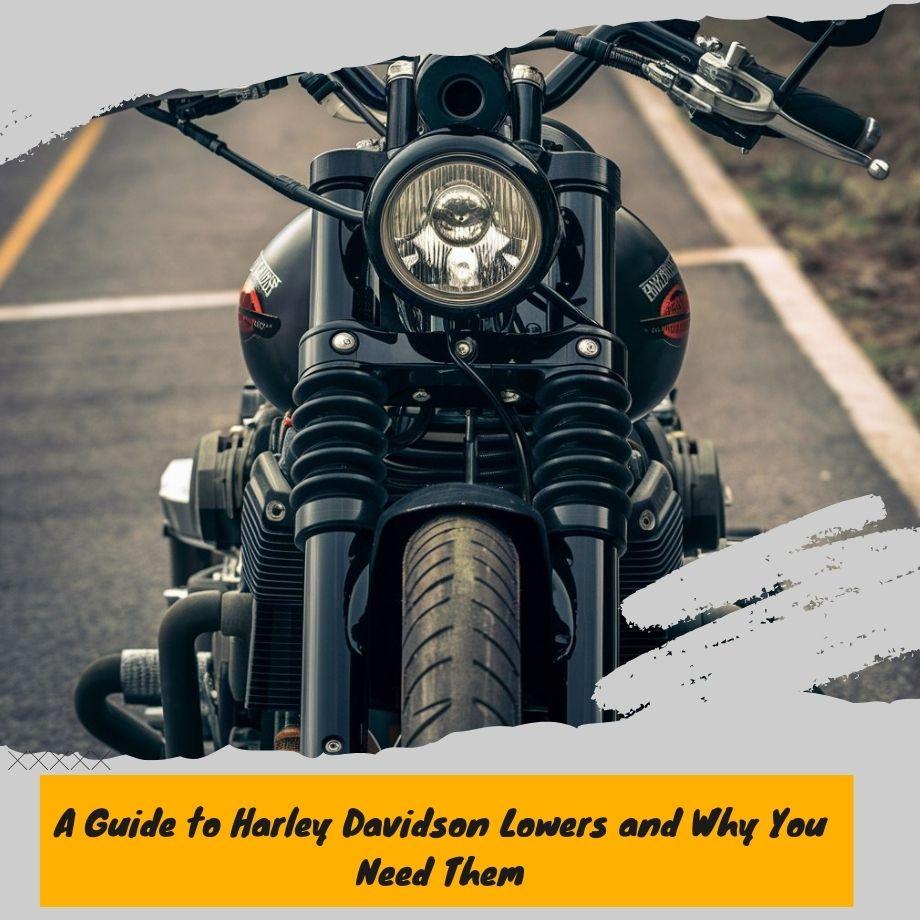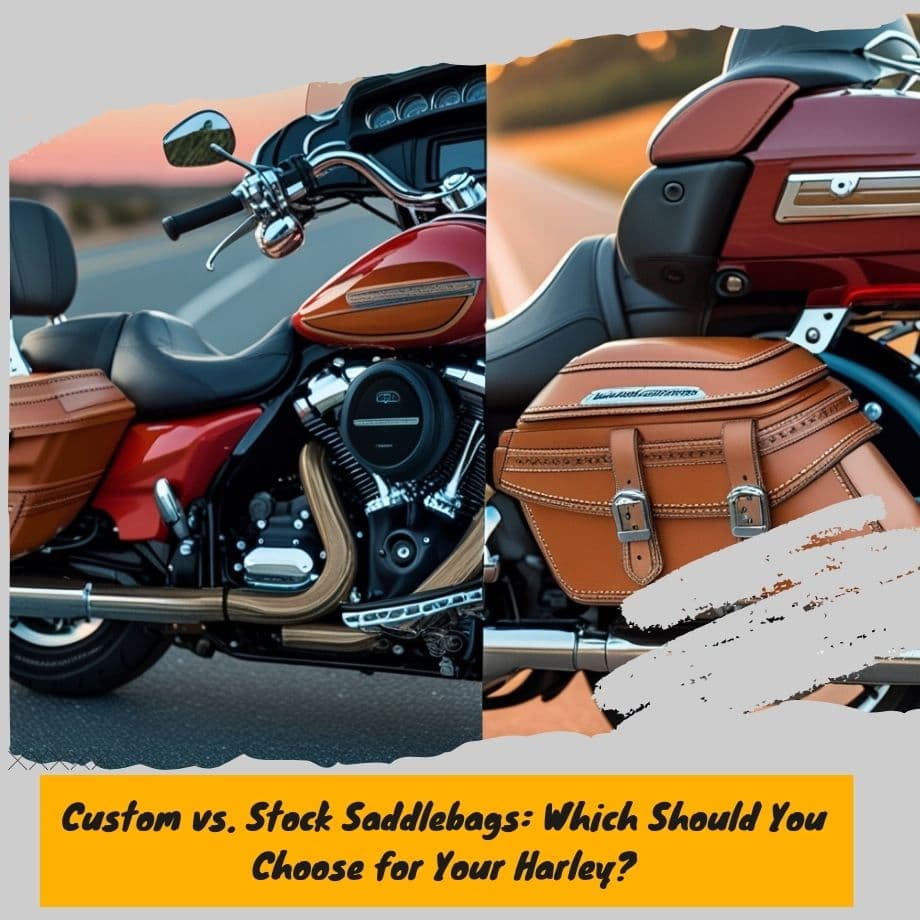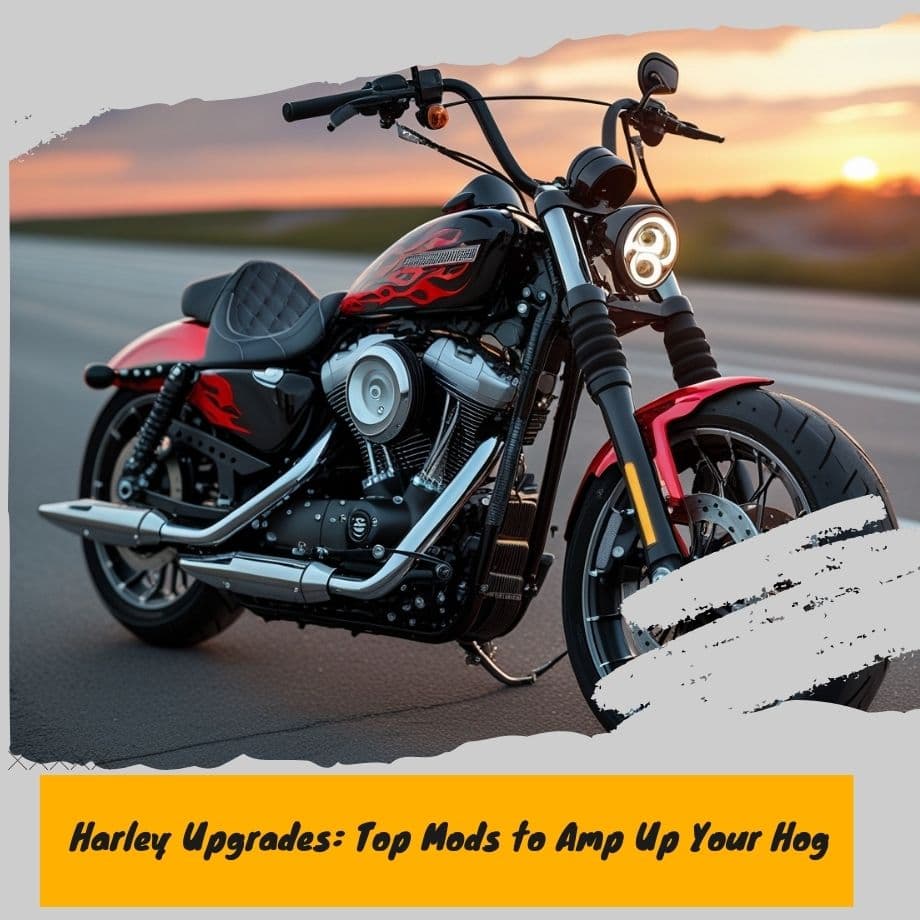Get Low: A Guide to Harley Davidson Lowers and Why You Need Them

Lowers, also known as fork lowers or triple trees, are a crucial component of a Harley-Davidson motorcycle's front suspension system.
They are located at the base of the front fork tubes and serve as the connection point between the forks and the motorcycle's frame.
The primary purpose of lowers is to provide a secure and sturdy mounting point for the front fork assembly, allowing it to pivot smoothly and absorb impacts from the road.
They play a vital role in the handling and stability of the motorcycle, as they help distribute the forces from the front suspension evenly across the frame.
Lowers consist of two main parts: the upper and lower triple trees.
The upper triple tree is connected to the handlebar stem, while the lower triple tree is attached to the front fork tubes.
Together, these components form a sturdy and rigid structure that ensures precise steering and control over the motorcycle's front end.
Types of Lowers on Harleys
Lowers on Harley-Davidson motorcycles come in various styles and materials, catering to different rider preferences and customization needs. The most common types include:
Stretched Lowers
These lowers extend the length of the motorcycle's frame, creating a longer and more stretched-out appearance. They are popular among riders who desire a more aggressive and raked-out stance for their Harleys.
Extended Lowers
Similar to stretched lowers, extended lowers increase the overall length of the frame, but to a lesser degree. They provide a subtle yet noticeable elongated look without going to the extreme of stretched lowers.
Steel Lowers
Crafted from high-quality steel, these lowers offer durability and strength. Steel lowers are often chosen for their rugged and classic appearance, as well as their ability to withstand the rigors of long-distance riding.
Aluminum Lowers
Lightweight and corrosion-resistant, aluminum lowers are a popular choice for riders seeking a sleek and modern look. They can also contribute to improved performance by reducing the overall weight of the motorcycle.
Billet Lowers
Billet lowers are precision-machined from a solid block of aluminum or other metal, resulting in a high-quality and visually striking component. These lowers are often intricately designed and are popular among riders who value intricate detailing and craftsmanship.
Bobbed Lowers
Bobbed lowers are shorter than stock lowers, giving the motorcycle a more compact and aggressive appearance. They are often paired with other bobber-style modifications for a minimalist and stripped-down look.
Factory Lowers vs Aftermarket Lowers
When it comes to lowers for your Harley-Davidson motorcycle, you have two main options: factory (or OEM) lowers and aftermarket lowers.
Factory lowers, also known as OEM (Original Equipment Manufacturer) lowers, are designed and manufactured by Harley-Davidson themselves.
These lowers are built to the exact specifications and tolerances required for each specific Harley model. They are designed to work seamlessly with the rest of the motorcycle's components, ensuring a perfect fit and optimal performance.
One of the main advantages of factory lowers is the assurance of quality and reliability.
Harley-Davidson has strict quality control measures in place, and their lowers are rigorously tested to meet the highest standards.
Additionally, factory lowers are covered by the manufacturer's warranty, providing peace of mind in case of any defects or issues.
However, factory lowers can be more expensive than aftermarket options, and they may offer fewer customization possibilities.
Harley-Davidson typically produces lowers in a limited range of styles and finishes, which may not align with every rider's aesthetic preferences.
On the other hand, aftermarket lowers are produced by third-party manufacturers and are designed to fit specific Harley models.
These lowers often come in a wide variety of styles, finishes, and materials, allowing riders to truly personalize the look of their motorcycles.
Aftermarket lowers can be more affordable than factory options, making them an attractive choice for riders on a budget.
They also offer a wider range of customization possibilities, from sleek and minimalist designs to bold and eye-catching styles.
However, it's important to note that the quality and fitment of aftermarket lowers can vary greatly depending on the manufacturer.
Some aftermarket lowers may not fit as precisely as factory options, potentially affecting performance or handling.
Additionally, aftermarket lowers may not be covered by the same warranties as OEM parts, so it's crucial to research and choose a reputable brand.
Ultimately, the choice between factory and aftermarket lowers comes down to personal preferences, budget, and priorities.
Factory lowers offer the assurance of quality and seamless integration, while aftermarket lowers provide more customization options and potential cost savings.
Lowers and Motorcycle Handling
Lowers on a Harley-Davidson motorcycle play a crucial role in influencing the bike's handling characteristics.
These components, which extend below the frame, impact several aspects of the riding experience, including steering, balance, and turning radius.
Lowers primarily affect the motorcycle's rake and trail, two key factors that determine how the bike handles.
The rake refers to the angle of the fork tubes relative to the ground, while the trail is the horizontal distance between the point where the steering axis intersects the ground and the center of the front tire's contact patch.
By lowering the bike's overall height, lowers effectively decrease the rake angle and increase the trail measurement.
This configuration results in improved straight-line stability and a more responsive steering feel. However, it also reduces the turning radius, making it slightly more challenging to execute tight turns or maneuver in confined spaces.
Furthermore, lowers can influence the bike's center of gravity.
By lowering the motorcycle's overall height, the center of gravity is brought closer to the ground, enhancing stability and reducing the likelihood of tipping over during low-speed maneuvers or while stopped.
It's important to note that the extent to which lowers affect handling characteristics depends on the specific design and dimensions of the components.
Significant changes in rake, trail, and overall height can have a substantial impact on the bike's handling, while more subtle modifications may result in more nuanced differences.
When considering lowers for a Harley-Davidson motorcycle, it's essential to strike a balance between the desired handling characteristics and the rider's preferences and riding style.
Some riders may prioritize agility and tight turning capabilities, while others may value increased straight-line stability and a more planted feel on the road.
Lowers for Different Harley Models
Harley-Davidson offers a wide range of motorcycle models, each with its unique style and riding characteristics. As such, the choice of lowers can vary depending on the specific model you own. Here's a breakdown of lowers suited for different Harley models:
Sportsters
Sportsters are known for their agile handling and compact size. For these bikes, lowers with a sleek and minimalist design are often preferred.
Popular options include fork lowers, which enhance the bike's aggressive stance, and slammed lowers that bring the front end closer to the ground for a more streamlined look.
Softails
Softail models are known for their classic styling and comfortable ride. For these bikes, lowers that complement the retro aesthetic are a popular choice.
Options like stretched lowers, which elongate the front end, or lowers with intricate designs and finishes can enhance the bike's vintage appeal.
Touring Models
Harley's touring models, such as the Road King and Street Glide, are built for long-distance rides and carrying luggage.
For these bikes, lowers that prioritize stability and handling are often preferred. Options like triple trees or lowers with integrated risers can improve steering and control, while maintaining a comfortable riding position.
Dyna Models
The Dyna lineup, including bikes like the Street Bob and Low Rider, is known for its versatility and performance. For these models, lowers that strike a balance between style and functionality are popular.
Options like billet lowers, which offer a sleek and lightweight design, or lowers with integrated brake caliper mounts can enhance both the bike's appearance and handling.
Trike Models
For Harley's trike models, such as the Tri Glide, lowers designed specifically for three-wheeled configurations are essential.
These lowers often feature wider triple trees or extended fork legs to accommodate the additional wheel and maintain proper handling characteristics.
It's important to note that many aftermarket lowers are designed to be compatible with multiple Harley models, allowing for customization across different bike styles.
Additionally, factors such as riding style, personal preferences, and intended use should be considered when selecting the appropriate lowers for your Harley-Davidson motorcycle.
Installing Lowers on a Harley
Installing lowers on a Harley-Davidson motorcycle is a popular modification that can enhance the bike's appearance and handling characteristics. The installation process can vary slightly depending on the specific model and the type of lowers being installed, but generally, it involves the following steps:
- Preparation: Begin by gathering the necessary tools, which may include wrenches, sockets, Allen keys, and a torque wrench. Ensure that you have a safe and level workspace to perform the installation.
- Removal of Existing Components: If your Harley already has lowers installed, you'll need to remove them first. This typically involves removing the mounting hardware, such as bolts or screws, and carefully detaching the lowers from the motorcycle frame.
- Cleaning and Inspection: Once the old lowers are removed, clean the mounting area on the frame thoroughly. Inspect the area for any signs of damage or corrosion, and address any issues before proceeding.
- Fitting the New Lowers: Carefully position the new lowers onto the motorcycle frame, ensuring proper alignment with the mounting points. Some lowers may require minor adjustments or modifications to fit correctly.
- Securing the Lowers: Using the provided hardware or recommended fasteners, secure the lowers to the frame. Follow the manufacturer's instructions for proper torque specifications and tightening sequences.
- Adjustment and Alignment: After the initial installation, you may need to make minor adjustments to ensure proper alignment and clearance. Check for any interference with other components, such as the exhaust system or suspension components.
- Final Inspection and Test Ride: Once the installation is complete, perform a thorough visual inspection to ensure that all components are securely fastened and properly aligned. Take the motorcycle for a test ride to check for any issues or potential interference.
The level of difficulty for installing lowers on a Harley can vary from moderate to challenging, depending on your mechanical skills and experience.
It's generally recommended to have a basic understanding of motorcycle mechanics and follow the manufacturer's instructions carefully. Additionally, some installations may require specialized tools or additional modifications, which could increase the complexity of the process.
Lowers for Customization and Style
Lowers offer Harley riders a unique opportunity to customize the appearance and style of their beloved machines. Beyond mere function, lowers allow for self-expression and the creation of a truly one-of-a-kind bike.
With a vast array of designs, finishes, and materials available in the aftermarket world, lowers enable riders to craft a motorcycle that reflects their personal taste and personality.
From sleek and minimalist to bold and eye-catching, the options are virtually limitless. Chrome, blacked-out, or painted lowers can complement or contrast with the rest of the bike's aesthetic, making a powerful visual statement.
For riders who view their Harley as an extension of themselves, lowers provide a canvas for artistic flair.
Custom engraving, intricate designs, and unique shapes can transform ordinary lowers into works of art. This level of personalization fosters a deeper connection between rider and machine, turning each motorcycle into a rolling showcase of individuality.
Moreover, lowers can be used to pay homage to specific eras, styles, or subcultures within the Harley community. (Benefits of Lower Fairing Speakers)
Vintage-inspired lowers evoke a sense of nostalgia, while contemporary designs showcase a more modern sensibility. Riders can even incorporate personal symbols, logos, or graphics, further enhancing the bike's uniqueness.
In the world of Harley-Davidson customization, lowers play a pivotal role in allowing riders to craft a bike that truly stands out from the crowd.
Whether subtle or bold, lowers offer a means of self-expression and a way to showcase one's individual style on the open road.
Cost of Harley-Davidson Lowers
The cost of lowers for your Harley-Davidson motorcycle can vary significantly depending on whether you opt for OEM (Original Equipment Manufacturer) parts or aftermarket alternatives.
OEM lowers from Harley-Davidson are typically more expensive but offer a perfect fit and finish, as well as the assurance of quality and durability backed by the manufacturer.
For most Harley models, you can expect to pay anywhere from $300 to $800 for a set of OEM lowers from the dealer. Prices may be higher for limited edition or specialty models.
While this may seem steep, keep in mind that these parts are designed and engineered specifically for your motorcycle, ensuring optimal performance and longevity.
On the other hand, aftermarket lowers from third-party manufacturers can be a more budget-friendly option, with prices ranging from $150 to $500 for a set.
However, it's crucial to do your research and choose reputable brands known for their quality and attention to detail. Poorly made aftermarket lowers can compromise the handling and safety of your bike.
When budgeting for lowers, consider the overall cost of ownership, including installation fees if you're not doing the work yourself.
It's also a good idea to factor in any additional hardware or components that may be required for a proper fit and installation.
To save money, keep an eye out for sales, bundle deals, or discounts offered by manufacturers or retailers.
Additionally, joining Harley-Davidson rider groups or forums can provide access to valuable information and potential deals on used or aftermarket parts from fellow enthusiasts.
Lowers and Motorcycle Laws/Regulations
Lowers on Harley-Davidson motorcycles are subject to various laws and regulations that vary by location.
Many areas have legal limits on the maximum width and length of motorcycle lowers to ensure they meet safety standards and don't pose a hazard on public roads.
In general, lowers that extend too far beyond the motorcycle's frame or handlebars can be considered illegal modifications.
Excessively wide lowers can make the bike unstable or difficult to maneuver, while long lowers increase the overall length, affecting turning radius and visibility.
Some states and municipalities enforce strict rules around lower dimensions, while others have more relaxed regulations.
It's crucial to research and understand the specific laws in your area before installing aftermarket lowers on your Harley.
Violating lower length or width limits can result in fines, citations, or even having your motorcycle deemed unfit for road use.
Law enforcement officers may measure your lowers during routine traffic stops or safety inspections.
When purchasing aftermarket lowers, reputable manufacturers will provide guidance on legal dimensions and any location-specific restrictions.
It's advisable to stick to lowers that comply with your local laws to avoid potential issues on the road.
Caring for and Maintaining Lowers
Proper care and maintenance of your Harley-Davidson's lowers are essential for ensuring their longevity, performance, and safety.
Regular cleaning and inspection can help prevent potential issues and keep your lowers looking their best.
Cleaning
Lowers are susceptible to dirt, debris, and road grime buildup, which can lead to premature wear and tear. It's recommended to clean your lowers regularly, especially after riding in adverse conditions.
Use a mild soap and water solution, along with a soft-bristled brush or cloth, to gently scrub away any accumulated dirt or grime. Avoid using harsh chemicals or abrasives, as they can damage the finish or surface of the lowers.
Inspection
Regularly inspecting your lowers is crucial for identifying any potential issues before they escalate.
Check for signs of wear, such as cracks, dents, or excessive scratches. Ensure that all bolts and fasteners are securely tightened, and inspect any pivot points or bearings for proper lubrication and smooth operation.
Potential Issues
Over time, lowers can experience various issues that require attention. One common problem is bushing wear, which can lead to excessive play or looseness in the suspension components.
Additionally, lowers can be susceptible to corrosion, especially in areas with high humidity or exposure to road salt. Regularly inspecting and addressing any issues can prevent more significant problems from developing.
Another potential issue is improper alignment or adjustment of the lowers, which can affect the handling and stability of your Harley-Davidson.
If you notice any unusual noises, vibrations, or handling issues, it's essential to have a qualified mechanic inspect and adjust the lowers as needed.
Lowers in Harley Culture and History
Lowers have played a significant role in the culture and history of Harley-Davidson motorcycles, particularly in the realm of customization and biker identity.
For many Harley enthusiasts, modifying their bikes with aftermarket parts like lowers is a way to express their individuality and create a unique riding experience.
In the early days of Harley-Davidson, riders often customized their bikes out of necessity, modifying parts to improve performance or durability.
As the brand grew in popularity, customization became a form of self-expression, with riders adding personal touches to their machines. Lowers were among the first parts to be customized, as they offered a way to change the bike's stance and appearance.
Over time, lowers evolved from functional modifications to stylistic statements. Different styles of lowers emerged, each representing a particular subculture within the Harley community.
For example, extended lowers became associated with the chopper and bobber scenes, while slammed lowers were popular among the low-rider crowd.
Beyond aesthetics, lowers also became a symbol of rebellion and non-conformity. In the counterculture movement of the 1960s and 70s, customized Harleys with radical lowers represented a rejection of mainstream societal norms.
Bikers took pride in their unique machines, and lowers were a way to showcase their individuality and defiance.
Today, lowers remain an integral part of Harley culture and customization. Riders continue to express their personal style and identity through their choice of lowers, whether they opt for classic designs or cutting-edge modern styles.
Manufacturers and aftermarket companies alike cater to this demand, offering a wide range of lowers to suit every taste and preference.
In the Harley community, lowers are more than just functional parts – they are a canvas for self-expression, a way to pay homage to the brand's rich history, and a symbol of the freedom and individuality that Harley-Davidson represents.







Leave a comment